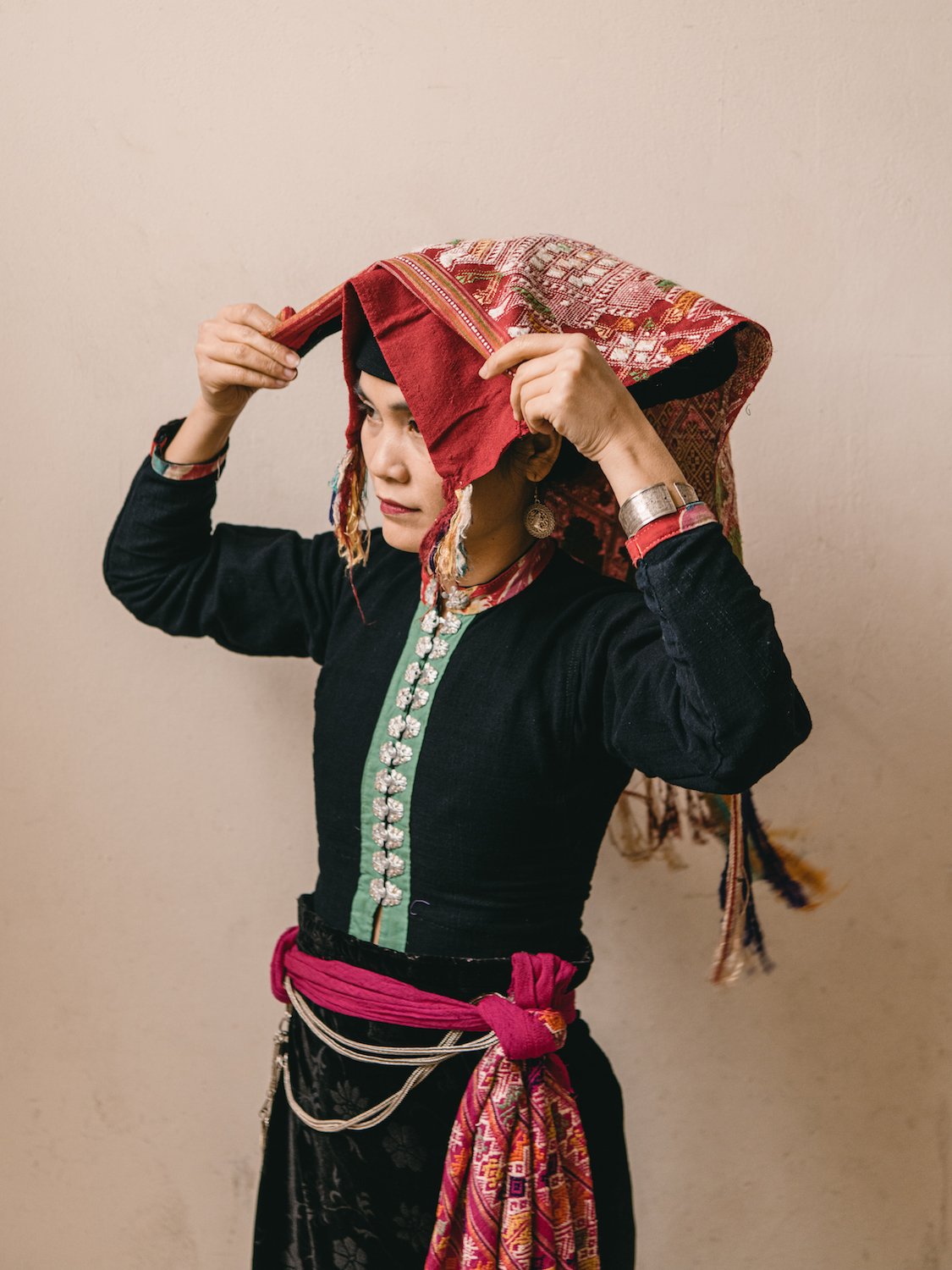Pieu Scarf
Ms Tinh
A JOURNEY of the Soul Captured in Cotton and Silk
Amid the dense forests and towering mountains of Vietnam’s breathtakingly beautiful northwest region, we find a distinct ethnic culture whose contributions to Vietnamese craftsmanship and visual identity cannot be understated.
Historical scholars divide the South Asian race into five distinct groups as follows: Mon Khmer group, Viet Muong group, Tay Thai group, and Hmong Dzao group and Southern Island group (Cham, Gia Rai, Ede) . So sharing a common origin, the Tay and the Thais, who settled in this region after fleeing their native lands in Thailand and China generations ago, and became the country's second largest - and one of the most easily recognizable - ethnic minorities, each with their own needlework, colors and ancient methods of silk production and weaving.
By far the most iconic garment produced, worn, and proudly treasured by the Tay tribes is the Pieu Scarf. Typically 1.6 metres long and 40cm wide, this precious symbol of the community plays a significant role in several aspects of the tribeswomen’s lives, and seamlessly integrates the practical with the spiritual, the beautiful with the mundane, and the past with the present.
A Symbol of Community
Made from cotton fabric that has been repeatedly dyed, most commonly with indigo - which forms such a cultural bedrock of southeast Asia - to ensure a deep and evocative hue, and embroidered to astonishing intricacy and effect with silk thread, the Pieu scarf is worn on a daily basis as an ancestral signifier of community life. It keeps the women cool in the humid summers, protects from the cold winter breezes, ensures their hair remains untangled while performing chores or farming, and prevents dust and pollution from damaging the skin.
As one might expect, the Pieu scarves worn while performing domestic duties and in day-to-day life aren’t necessarily elaborately-decorated and embroidered. Indeed, such scarves tend to be plain and practical, with the more spectacular creations reserved for courtship rituals, spiritual milestones, festivals, musical performances, and the renowned Thai Xoe traditional dances.
Ancestral Craftsmanship, Timeless Skills
Handed down from mother to daughter in an unbroken chain, the time-honoured methods of Pieu scarf production are the treasure of the Tay people. While certain embroidered symbols and patterns are almost ubiquitous in the scarves’ design, each woman imaginatively embroiders her scarf to make it not only unique, but reflective of her personality, her wishes, aspirations, and dreams.
With an array of processes implemented, including spinning, stitching, silkwork, and needlework, elements including plants, animals, petals, leaves, and celestial bodies are meticulously woven into the design to beautify and personalise the item.
Certain traditional practices are commonplace in Pieu scarf design, including stylising the edges of the scarf with interwoven green, purple, red, and yellow thread. Often, the women will decorate the borders of their scarf with iconic buds made from rolled pieces of red cloth, shaped to resemble fern fronds (a shape which holds special significance to the Tay people, and which can be seen represented in the roof of their homes). Elsewhere on the scarves, geometric shapes ranging from squares to diamonds, triangles, and zig-zags are standard, adding to the symbolic idiom of their design.
A Thousand Stories, Woven in Silk
As is so common in the handicrafts of this corner of the world, the symbols, patterns, and imagery found on Pieu scarves has its own stories to tell.
The floral designs which are central to the scarves represent the high status of women in Tay communities, symbolising their empowerment and their central role in tribal life. They indicate not only their artistic vision and aspirations, but also their entire perspective on life and strength of perseverance - just as the flowers bloom year in, year out. Diamonds symbolise success and bring good luck, prosperity and longevity, and different animals and birds each have their own symbolic significance, too.
When it comes to love and relationships, the scarves have their own unique role to play. In a playful and ancient tradition, men seeking to capture the heart of a tribeswoman will grab the cloth balls on the border of her scarf, and will exchange a silver bracelet or other item of jewellery in exchange for her scarf. Furthermore, men will carefully consider the quality and expertise of a woman’s weaving when seeking a wife, and the scarf itself becomes a symbol of the loyal bond between partners and their families.
The Spiritual Significance of the Pieu Scarf
The spiritual aspect of the Pieu scarf extends far beyond courtship and marriage, and interweaves the tribespeople’s beliefs with the practicalities of everyday life. The patterns and colours which beautify the garments are indicative of the tribal religions, invoking their gods to bring protection and guidance to the women who wear them. Indeed, the circular buds which surround the borders are believed to have talismanic properties, warding off evil and protecting the wearer from harm.
Even at the very end of life, the Pieu scarf has a role to play. The scarves are believed to represent one’s path from this world to the next, and numerous scarves are typically added to the funeral pyre to ease the soul’s passage to the heavenly realm. What’s more, when a husband or wife passes away, the wife’s scarf is cut into two pieces. One piece will cover the face of the deceased, and the other will remain with the surviving partner for the rest of their life, playing its role in their own funeral, when the time finally comes. This ritual, and the love and artistry which goes into the scarf-making itself, is one which connects the two souls and allows them to meet in the afterlife.
Photo source: TextileSeekers

